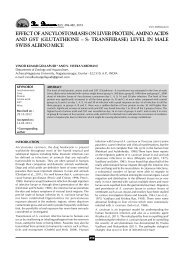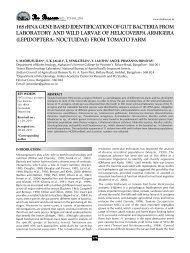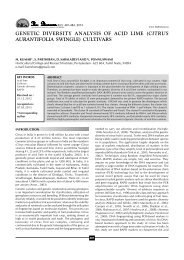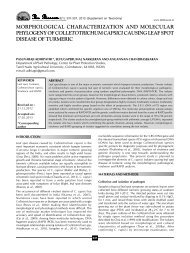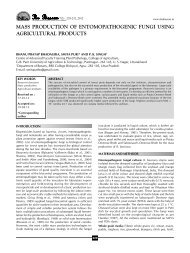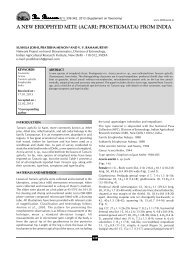Relative efficacy of biopesticides and newer ... - THE BIOSCAN
Relative efficacy of biopesticides and newer ... - THE BIOSCAN
Relative efficacy of biopesticides and newer ... - THE BIOSCAN
Create successful ePaper yourself
Turn your PDF publications into a flip-book with our unique Google optimized e-Paper software.
NSave Nature to Survive<br />
8(2): 579-582, 2013<br />
www.thebioscan.in<br />
RELATIVE EFFICACY OF BIOPESTICIDES AND NEWER INSECTICIDES<br />
AGAINST HELICOVERPA ARMIGERA (HUB.) IN TOMATO<br />
S. K. JAT* AND O. P. AMETA<br />
Department <strong>of</strong> Entomology, Rajasthan College <strong>of</strong> Agriculture,<br />
Maharana Pratap University <strong>of</strong> Agriculture <strong>and</strong> Technology, Udaipur - 313 001<br />
e-mail: ento89suresh@gmail.com.<br />
KEYWORDS<br />
Bio-pesticides <strong>and</strong> <strong>newer</strong><br />
insecticides<br />
Helicoverpa armigera<br />
(Hub.) <strong>and</strong> tomato<br />
Received on :<br />
07.12.2012<br />
Accepted on :<br />
07.04.2013<br />
*Corresponding<br />
author<br />
ABSTRACT<br />
<strong>Relative</strong> <strong>efficacy</strong> <strong>of</strong> <strong>biopesticides</strong> <strong>and</strong> <strong>newer</strong> insecticides against Helicoverpa armigera (Hub.) on tomato was<br />
evaluated in field conditions. The results showed that the three applications <strong>of</strong> flubendiamide 480 SC at 200 mL/<br />
ha was found significantly most effective, which caused highest mean reduction <strong>of</strong> population <strong>of</strong> tomato fruit<br />
borer larvae <strong>and</strong> fruit damage, 89.94 <strong>and</strong> 3.10 per cent. It was followed by spinosad 45 SC at 200 mL/ha <strong>and</strong><br />
HaNPV at 250 LE/ha with 74.67 <strong>and</strong> 74.10 per cent mean reduction, respectively <strong>and</strong> were at par with each other<br />
<strong>and</strong> the spinosad 45 SC @ 200 mL/ha observed (4.86) per cent fruit damage followed by HaNPV 250 LE/ha, Bt<br />
@1.5 kg/ha <strong>and</strong> Beta-cyfluthrin 2.5 SC were found moderately effective treatment being 8.16, 10.14 <strong>and</strong> 6.68 per<br />
cent fruit damage, respectively. The highest marketable yield <strong>of</strong> 265.68q/ha was recorded in case <strong>of</strong> Flubendiamide<br />
480 SC @ 200 mL/ha with highest C: B ratio <strong>of</strong> 1:2.075. It was followed by Spinosad 45 SC @ 200mL/ha (251.29<br />
q/ha) <strong>and</strong> Beta-cyfluthrin 2.5 SC @ 750 ml/ha (238.38 q/ha).<br />
INTRODUCTION<br />
Tomato (Lycopersicon esculentum Mill) is one <strong>of</strong> the most<br />
popular <strong>and</strong> widely grown vegetables throughout the world<br />
ranking second in importance after potato in India. Tomato<br />
fruit borer, Helicoverpa armigera (Hubner) is very important<br />
pest which causes 40-50 percent damage to the tomato crop<br />
(Pareek <strong>and</strong> Bhargava, 2003). H. armigera is a charismatic<br />
insect pest in agriculture accounting for the consumption <strong>of</strong><br />
over 55 percent <strong>of</strong> total insecticides used in India (Puri, 1995).<br />
The fruit borer or gram pod borer or American bollworm,<br />
Helicoverpa armigera (Hub.) is the most important pest<br />
infesting tomato. It has been reported on 181 cultivated <strong>and</strong><br />
wild plant species belonging to 45 families in India (Manjunath<br />
et al., 1989). It is basically a polyphagous pest. It is a serious<br />
pest <strong>of</strong> several economically important agricultural crops like<br />
cotton, tomato, pigeonpea <strong>and</strong> chickpea besides oil seeds,<br />
cereals <strong>and</strong> vegetable crops etc, but it mainly attacks tomato<br />
<strong>and</strong> chickpea. This is a key pest as it attacks fruits <strong>and</strong> makes<br />
fruits unfit for human consumption causing considerable crop<br />
loss up to 55 percent in yield (Selvanarayanan, 2000). The<br />
botanicals <strong>and</strong> bio-pesticides have given encouraging results<br />
against the insect pests <strong>of</strong> agricultural importance. To combat<br />
the problems caused by chemical insecticides it is imperative<br />
to use botanicals <strong>and</strong> bio-pesticides viz. NPV <strong>and</strong> BT against<br />
this noxious pest, so that the use <strong>of</strong> pesticides can be minimized.<br />
MATERIALS AND METHODS<br />
The methodology used for conducting the experiment on<br />
“<strong>Relative</strong> <strong>efficacy</strong> <strong>of</strong> <strong>biopesticides</strong> <strong>and</strong> <strong>newer</strong> insecticides<br />
against Helicoverpa armigera (Hub.) in tomato”was carried<br />
out at Instructional Farm, Rajasthan College <strong>of</strong> Agriculture,<br />
Maharana Pratap University <strong>of</strong> Agriculture <strong>and</strong> Technology,<br />
Udaipur during kharif (July to December 2011). The seeds <strong>of</strong><br />
tomato variety, BSS-908 Priya were sown in well prepared<br />
nursery beds in third week <strong>of</strong> June <strong>and</strong> transplanting was done<br />
during the second week <strong>of</strong> August 2011 in the the plots<br />
measuring 4.6 X 3.5 m2 having row to row <strong>and</strong> plant to plant<br />
distance <strong>of</strong> 60cm <strong>and</strong> 45cm, respectively. The experiment<br />
was laid out in R<strong>and</strong>omized Block Design (RBD), each<br />
replicated thrice. To estimate the population <strong>of</strong> H. armigera<br />
larvae “Direct visual counting method” was used. Ten plants<br />
were r<strong>and</strong>omly selected <strong>and</strong> tagged from each replication or<br />
plot. The observation was recorded by physical count <strong>of</strong> test<br />
insect. The borer infested <strong>and</strong> healthy fruits <strong>of</strong> individual plots<br />
were sorted out after each harvest <strong>and</strong> the numbers <strong>of</strong> infested<br />
<strong>and</strong> marketable fruits were recorded. The fruit infestation <strong>and</strong><br />
larval population were recorded before <strong>and</strong> 3, 5 <strong>and</strong> 7 days<br />
after spraying <strong>of</strong> each treatments.<br />
Statistical Analysis<br />
The population data <strong>of</strong> H. armigera obtained was subjected<br />
for the conversion into per cent reduction using Henderson<br />
<strong>and</strong> Tilton (1952) formula as under:<br />
T<br />
Per cent reduction in population = 100 [ 1- a<br />
X C b<br />
]<br />
T b<br />
X C a<br />
Where,<br />
T a<br />
= Number <strong>of</strong> insects after treatment<br />
T b<br />
= Number <strong>of</strong> insects before treatment<br />
579
S. K. JAT AND O. P. AMETA<br />
Table 1: Efficacy <strong>of</strong> <strong>newer</strong> insecticides <strong>and</strong> bio-pesticides against H. armigera larvae infesting tomato crop during kharif 2011- 12<br />
S. No. Treatments Dose,mL/ Reduction in larval population days after spray (%)<br />
ha,kg/ha<br />
1 st Spray 2 nd Spray 3 rd Spray<br />
3 DAS ** 5 DAS 7 DAS 3 DAS 5 DAS 7 DAS 3 DAS 5 DAS 7 DAS<br />
T 1<br />
Flubendiamide 4 200 53.31(64.30 * ) 57.49(71.10) 54.29(65.90) 55.43(67.77) 60.18(75.23) 54.59(66.39) 64.21(81.01) 71.67(89.94) 65.90(83.23)<br />
80 SC<br />
T 2<br />
Spinosad 45 SC 200 50.32(59.21) 54.62(66.44) 49.35(57.56) 51.43(61.12) 54.67(66.55) 49.64(58.06) 59.80(74.67) 63.56(80.05) 61.14(76.67)<br />
T 3<br />
NPV 250 47.98(55.19) 50.06(58.75) 47.01(53.50) 49.02(57.00) 50.31(59.21) 46.18(52.07) 53.75(65.00) 59.41(74.10) 56.74(69.92)<br />
T 4<br />
Bt 1.5 47.27(53.95) 49.63(58.04) 46.72(52.99) 48.41(55.93) 48.53(56.15) 45.66(51.14) 47.04(53.55) 50.02(58.72) 50.78(60.03)<br />
T 5<br />
Beta-cyfluthrin 750 49.64(58.06) 53.48(64.59) 49.03(56.99) 46.72(53.00) 51.71(61.59) 47.91(55.07) 49.68(58.12) 55.17(67.37) 53.14(64.01)<br />
2.5 SC<br />
T 6<br />
NSKE 5% 5% 41.18(43.35) 42.76(46.10) 39.69(40.80) 37.51(37.10) 39.56(40.56) 36.87(36.07) 38.89(39.42) 41.10(43.22) 39.94(41.25)<br />
T 7<br />
NLE 5% 5% 38.73(39.15) 39.81(41.00) 37.66(37.33) 35.54(33.85) 36.71(35.80) 34.40(31.93) 35.92(34.42) 37.53(37.12) 38.11(38.10)<br />
S.Em+ 0.92 0.73 1.01 0.92 1.01 0.94 1.03 1.09 0.99<br />
CD 5% 2.85 2.26 3.13 2.85 3.12 2.91 3.19 3.34 3.02<br />
*Figure in parentheses are retransformed values; ** Days after spray<br />
Table 2: Efficacy <strong>of</strong> <strong>newer</strong> insecticides <strong>and</strong> bio-pesticides on fruit damage caused by H. armigera larvae in tomato during kharif 2011-12<br />
S.No Treatments Dose, Pretreatment Mean per cent fruit damage<br />
mL/ha, fruit damage<br />
kg/ha<br />
1 st spray 2 nd spray 3 rd spray<br />
3 DAS ** 5 DAS 7 DAS 3 DAS 5 DAS 7 DAS 3 DAS 5 DAS 7 DAS<br />
T 1<br />
Flubendiamide 200 21.67(13.65) 16.77(8.33 * ) 12.73(4.86) 15.73(7.35) 14.42(6.20) 11.25 (3.81) 15.09(6.78) 13.24(5.25) 10.14(3.10) 13.76(5.68)<br />
480 SC<br />
T 2<br />
Spinosad 45SC 200 22.70(14.90) 18.41(10.00) 15.66(7.29) 19.54(11.20) 17.92(9.47) 14.64(6.39) 19.01(10.61) 16.59(8.16) 12.73(4.86) 16.84(8.40)<br />
T 3<br />
NPV 250 21.93(13.95) 21.01(12.89) 18.57(10.14) 21.62(13.58) 20.09(11.80) 18.76(10.34) 23.01(15.28) 20.61(12.39) 16.60(8.16) 19.32(10.95)<br />
T 4<br />
Bt 1.5 22.68(14.87) 21.38(13.29) 18.99(10.59) 21.78(13.77) 20.58(12.36) 19.55(11.20) 23.85(16.35) 21.58(13.53) 18.57(10.14) 20.97(12.81)<br />
T 5<br />
Beta-cyfluthrin 750 21.34(13.25) 19.00(10.60) 16.64(8.20) 20.10(11.82) 22.61(14.78) 18.86 (10.45) 20.47 (12.23) 19.50(11.14) 14.98(6.68) 18.15(9.71)<br />
2.5 SC<br />
T 6<br />
NSKE 5% 22.86(15.10) 23.89(16.40) 20.87(12.70) 27.52 (21.35) 28.19 (22.31) 25.48(18.50) 29.55 (24.32) 26.03(19.25) 23.94(16.46) 27.75(21.68)<br />
T 7<br />
NLE 5% 22.93(15.22) 24.61(17.34) 22.05(14.09) 28.02(22.07) 29.47(24.20) 27.46(21.26) 31.67(27.56) 28.35 (22.55) 26.65 (20.12) 29.99 (24.99)<br />
T 8<br />
Control - 22.59(14.78) 25.91(19.10) 30.34(25.53) 33.80(30.95) 34.82(32.60) 36.13(34.77) 37.19(36.54) 38.17(38.20) 38.84(39.33) 40.19(41.64)<br />
S. Em+ 0.53 0.37 0.31 0.35 0.36 0.32 0.38 0.34 0.30 0.39<br />
CD (P=0.05) 1.61 1.12 0.93 1.07 1.08 0.96 1.16 1.02 0.92 1.18<br />
* Figure in parentheses are retransformed values; ** Days after spray<br />
580
RELATIVE EFFICACY OF BIOPESTICIDES<br />
Table 3: Economics <strong>and</strong> cost benefit ratio <strong>of</strong> different treatments against H. armigera in tomato during 2011-12<br />
Treatments No. <strong>of</strong> Average Gross return Increased Value <strong>of</strong> Management Net pr<strong>of</strong>it C:B ratio<br />
sprays yield (q/ha) (Rs.) yield over increased yield Cost (labour+ (Rs./ha)<br />
control over control insecticide)<br />
(q/ha) (Rs./ha) (Rs./ha)<br />
T 1<br />
Flubendiamide 480 SC 3 265.68 398520 145.17 217755 11220 206535 1:2.075<br />
@200ml/ha<br />
T 2<br />
Spinosad 45 SC 3 251.29 376935 130.78 196170 2520 193650 1:2.056<br />
@ 200ml/ha<br />
T 3<br />
Ha NPV @ 250LE/ha 3 226.40 339600 105.89 158835 3420 155415 1:1.843<br />
T 4<br />
Bt @ 1.5 kg/ha 3 217.74 326610 97.23 145845 2595 143250 1:1.781<br />
T 5<br />
Beta-cyfluthrin 3 238.8 357570 117.87 176805 3262 173543 1:1.943<br />
2.5 SC @ 750ml/ha<br />
T 6<br />
NSKE @ 5% 3 167.25 250875 46.74 70110 2820 67290 1:1.366<br />
T 7<br />
NLE @ 5% 3 157.23 235845 36.72 55080 2025 53055 1:1.290<br />
T 8<br />
Control 0 120.51 180765 - - - - -<br />
(1) Present price <strong>of</strong> insecticides: Flubendiamide Rs. = 160/10 ml Beta-cyfluthrin Rs. =730/l; (2)Labour charge: 4 labour @ Rs. 135 Spinosad Rs. = 725/500 ml NSKE Rs. = 20/kg; (3)Sale<br />
price <strong>of</strong> tomato Rs. = 15/kg NPV Rs. = 600/250 LE NLE = 1 labour ; Bt Rs. =650/l<br />
C a<br />
= Number <strong>of</strong> insects in untreated check after treatment<br />
C b<br />
= Number <strong>of</strong> insects in untreated check before treatment.<br />
The reduction percentage figures were transferred into arc<br />
sine values <strong>and</strong> subjected to analysis <strong>of</strong> variance.<br />
The data on percentage infestation <strong>of</strong> tomato fruits by borer<br />
was calculated at each picking by counting damage <strong>and</strong><br />
healthy fruits in each spray application. The mean per cent<br />
fruit damage was calculated using formula:<br />
Number <strong>of</strong> damaged fruits<br />
Mean fruit damage (%) = x 100<br />
Total number <strong>of</strong> fruits<br />
RESULTS AND DISCUSSION<br />
The result <strong>of</strong> effectiveness <strong>of</strong> different insecticidal treatments<br />
against tomato fruit borer, H. armigera showed that all the<br />
treatments were significantly superior over control in terms <strong>of</strong><br />
mean reduction <strong>of</strong> tomato fruit borer larvae, mean fruit damage<br />
<strong>and</strong> marketable fruit yield. Three applications <strong>of</strong> flubendiamide<br />
480 SC at 200 mL/ha was found significantly most effective,<br />
which caused highest mean reduction <strong>of</strong> 89.94 per cent in<br />
population <strong>of</strong> tomato fruit borer larvae. It was followed by<br />
spinosad 45 SC at 200 ml/ha <strong>and</strong> HaNPV at 250 LE/ha with<br />
74.67 <strong>and</strong> 74.10 per cent mean reduction, respectively <strong>and</strong><br />
were at par with each other. Beta-cyfluthrin 2.5 SC at 750 mL/<br />
ha <strong>and</strong> BT at 1.5 kg/ha were found moderately effective<br />
treatment with 67.37 <strong>and</strong> 60.03 per cent mean reduction <strong>of</strong><br />
fruit borer larvae. The <strong>efficacy</strong> <strong>of</strong> flubendiamide 480 SC at 200<br />
mL/ha was manifested in terms <strong>of</strong> least mean fruit damage <strong>of</strong><br />
3.10 per cent, while, the spinosad 45 SC @ 200 mL/ha with<br />
mean fruit damage <strong>of</strong> 4.86 percent followed the above <strong>and</strong><br />
was next in order <strong>of</strong> effectiveness. HaNPV 250 LE/ha, BT @1.5<br />
kg/ha <strong>and</strong> Beta-cyfluthrin 2.5 SC were found moderately<br />
effective treatment with 8.16, 10.14 <strong>and</strong> 6.68 per cent mean<br />
fruit damage, respectively.<br />
The highest marketable yield <strong>of</strong> 265.68 q/ha was recorded in<br />
case <strong>of</strong> Flubendiamide 480 SC @ 200 mL/ha with highest C: B<br />
ratio <strong>of</strong> 1:2.075. It was followed by Spinosad 45 SC @ 200mL/<br />
ha (251.29 q/ha) <strong>and</strong> Beta-cyfluthrin 2.5 SC @ 750 mL/ha<br />
(238.38 q/ha). HaNPV @ 250 LE/ha <strong>and</strong> BT @ 1.5 kg/ha,<br />
which yielded 226.40 <strong>and</strong> 217.74 q/ha, respectively.<br />
These findings are in close conformity with the findings <strong>of</strong><br />
Kuttalam et al. (2008) who reported that flubendiamide 480<br />
SC at 48 g a. i. /ha was significantly superior in reducing H.<br />
armigera population <strong>and</strong> fruit damage in tomato. Similarily,<br />
the effectiveness <strong>of</strong> flubendiamide 480 SC against H. armigera<br />
was also reported by Ameta <strong>and</strong> Arunabh (2007) in tomato,<br />
Ameta <strong>and</strong> Kumar (2008) in chilli. Earlier, Gopalakrishnan<br />
<strong>and</strong> Ashokan (1998) reported that nuclear polyhedrosis virus<br />
significantly decreased larval count <strong>of</strong> H. armigera <strong>and</strong><br />
increased fruit yield <strong>of</strong> tomato. Similarily, the effectiveness <strong>of</strong><br />
nuclear polyhedrosis virus against H. armigera was also<br />
reported by Sivaprakasam (1998), Wanjari et al. (1998). Murray<br />
et al. (2005) reported that Spinosad 45SC was consistently<br />
superior to other tested insecticides against H. armigera.<br />
REFERENCES<br />
Ameta, O. P. <strong>and</strong> Arunabh, J. 2007. Evaluation <strong>of</strong> Beta- Cyfluthrin 25<br />
SC againsttomato fruit borer, Helicoverpa armigera (Hub.). J. Applied<br />
Zoological Researches. 18: 54-58.<br />
Ameta, O. P. <strong>and</strong> Kumar, A. 2008. Efficacy <strong>of</strong> flubendiamide against<br />
Helicoverpa armigera (Hub.) <strong>and</strong> Spodoptera litura (Fab.) in chilli.<br />
Pestology. 32: 26-29.<br />
Gopalakrishnan, C. <strong>and</strong> Ashokan, R. 1998. On farm trails with HaNPV<br />
against Helicoverpa armigera Hub. (Lepidoptera: Noctuidae) on<br />
tomato. Advances in IPM for Horticultural Crops. Proceedings <strong>of</strong> the<br />
First National Symposium on Pest Management in Horticultural Crops<br />
Environmental Implications <strong>and</strong> Thrusts, Bangalore, India, 15-17<br />
October, 1997-98, 215-217.<br />
Henderson, C. F. <strong>and</strong> Tilton, E. W. 1952. Tests with acaricides against<br />
the brown wheat mite. Journal <strong>of</strong> Economic Entomology. 48: 157-<br />
161.<br />
Kuttalam, S., Kumar, B. V., Kumaran, N. <strong>and</strong> Boomathi, N. 2008.<br />
Evaluation <strong>of</strong> bio-<strong>efficacy</strong> <strong>of</strong> flubendiamide 480SC against fruit borer,<br />
Helicoverpa armigera (Hub.) in tomato. Pestology. 32: 13-16.<br />
Manjunath, T. M., Bhatnagar, V. S., Pawar, C. S. <strong>and</strong> Sithanantham,<br />
S. 1989. Economic importance <strong>of</strong> Heliothis spp. in India <strong>and</strong> an<br />
assessment <strong>of</strong> their natural enemies <strong>and</strong> host plants. In: Proceedings<br />
<strong>of</strong> workshop on Biological Control <strong>of</strong> Heliothis. Increasing the<br />
effectiveness <strong>of</strong> natural enemies (Ed. King, I.G. <strong>and</strong> Jackson, R.D.),<br />
Far Eastern Regional Research Office, United States, Department <strong>of</strong><br />
Agriculture, New Delhi. pp. 197-228.<br />
Murray, D. A. H., Lloyed, R. J. <strong>and</strong> Hopkinson, J. E. 2005. Efficacy <strong>of</strong><br />
<strong>newer</strong> insecticides for management <strong>of</strong> Helicoverpa spp. (Lepidoptera:<br />
Noctuidae) in Australian grain crop. Australian J. Entomology. 44:<br />
581
S. K. JAT AND O. P. AMETA<br />
62-67.<br />
Pareek, P. L. <strong>and</strong> Bhargava, M. C. 2003. Estimation <strong>of</strong> avoidable<br />
losses in vegetables caused by borers under semi arid condition <strong>of</strong><br />
Rajasthan. Insect Envioronment. 9: 59-60.<br />
Puri, S. N. 1995. Present status <strong>of</strong> IPM in India. Proceeding <strong>of</strong> National<br />
Seminar on Integrated Pest Management in Agriculture, December<br />
29-30, 1995. Nagpur, Maharashtra.<br />
Selvanarayanan, V. 2000. Host plant resistance in tomato against fruit<br />
borer, Helicoverpa armigera (Hub.). Thesis, Annamalai University,<br />
Annamalainayar, India.<br />
Sivaprakasam, N. 1998. Control <strong>of</strong> tomato fruit borer, Helicoverpa<br />
armigera (Hub.) by nuclear polyhedrosis virus in comparison with<br />
other treatments. Indian J. Agricultural Sciences. 68: 801-802.<br />
Wanjari, R. R., More, G. D., Supare, N. R., Turkar, K. S. <strong>and</strong> Agarkar,<br />
V. K. 1998. Management <strong>of</strong> Helicoverpa armigera (Hub.) on chickpea<br />
with some herbal, chemical <strong>and</strong> bio-pesticides. J. Soils <strong>and</strong> Crops, 8:<br />
34-37.<br />
582



